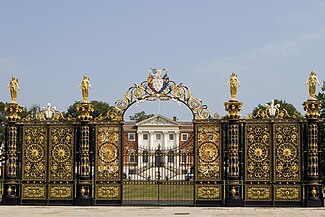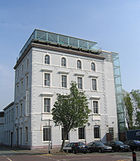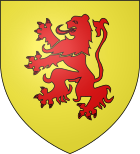|
The Cheshire Portal
WelcomeCheshire Plain from the Mid Cheshire Ridge
Cheshire is a ceremonial county in the North West of England. Chester is the county town, and formerly gave its name to the county. The largest town is Warrington, and other major towns include Congleton, Crewe, Ellesmere Port, Macclesfield, Nantwich, Northwich, Runcorn, Sandbach, Widnes, Wilmslow and Winsford. The county is administered as four unitary authorities. Cheshire occupies a boulder clay plain (pictured) which separates the hills of North Wales from the Peak District of Derbyshire. The county covers an area of 2,343 km2 (905 sq mi), with a high point of 559 m (1,834 ft) elevation. The estimated population is a little over one million, 19th highest in England, with a population density of around 450 people per km2. The county was created in around 920, but the area has a long history of human occupation dating back to before the last Ice Age. Deva was a major Roman fort, and Cheshire played an important part in the Civil War. Predominantly rural, the county is historically famous for the production of Cheshire cheese, salt and silk. During the 19th century, towns in the north of the county were pioneers of the chemical industry, while Crewe became a major railway junction and engineering facility. Selected articleIn the early fourteenth century, tensions between villagers from Darnhall and Over, Cheshire, and their feudal lord, the Abbot of Vale Royal Abbey, erupted into violence over whether they had villein—that is, servile—status. The villagers argued not, while the Abbey believed it was due the villagers' feudal service. Founded by Edward I in 1274, the Cistercian Abbey had been unpopular with locals from the start. This was primarily because it had been granted, in its endowment, exclusive forest rights which surrounding villages saw as theirs by custom, and other feudal dues they did not believe they had to pay. Moreover, the rigorous enforcement of these rights by successive abbots was felt to be excessively harsh. The villagers resented being treated as serfs and made repeated attempts to reject the Abbey's feudal overlordship. The villagers' efforts ranged from appeals to the Abbot, the King's Chief Justice in Cheshire and even to the King and Queen; the latter, at least, appears to have been somewhat sympathetic to their cause. On each occasion, though, the villagers were unsuccessful and were unable to secure release from their villeinhood. The abbots, for their part, may have had significant financial pressures on them. Their house had commenced major building works in 1277, but then lost much of its early royal funding following Edward I's invasion of Wales the same year, which diverted both his money and masons from them. This may have accounted for the strict enforcement of their rights. Their tenants' struggle turned increasingly violent from 1326. (Full article...) Selected imageWarrington Town Hall, built in 1750, was formerly the Georgian country mansion of Bank Hall. It was sold to Warrington council in 1870. The elaborately ornamented gateway, known as the Golden Gates, was exhibited at the London Exhibition of 1862. Credit: Racklever (22 July 2006) In this monthSeptember 1707: Physician Nathan Alcock born at Aston. 1 September 1858: Crewe and Shrewsbury Railway opened. 1 September 1876: Activist and editor Harriet Shaw Weaver born in Frodsham. 1 September 2007: Cheshire Regiment merged into the Mercian Regiment. 7 September 1917: Pilot and charity founder Leonard Cheshire born in Chester. 8 September 1949: Bernard Lovell and Charles Husband first meet at Jodrell Bank to discuss the 250-ft radio telescope. 14 September 1804: Landowner and poet Rowland Egerton-Warburton born in Norley. 16 September 1947: Comedian Russ Abbot born in Chester. 21 September 1642: Charles I brought his army to Chester during the Civil War. 24 September 1645: Battle of Rowton Heath (memorial pictured). 29 September 1908: Cheshire County Cricket Club founded. Selected listThe 23 listed buildings in Widnes include five at Grade II* and the remainder at Grade II. Widnes's oldest listed building is St Luke's Church, Farnworth, which dates from the 12th century. Other early structures include two 18th-century houses and a bridewell dating from 1827. In 1833, the Sankey Canal reached the area; the lock at the canal's terminus is another early listed structure. The St Helens and Runcorn Gap Railway established a terminus adjacent to the canal, the world's first railway dock was constructed there and, in 1847, a chemical factory was established nearby. More chemical factories were built during the second half of the 19th century, and the town grew, absorbing the previously separated hamlets of Appleton, Cronton, Farnworth and Upton. The listed structures dating from after 1847 – including churches, cemetery chapels, the town hall, a war memorial, a health centre, railway stations, two bridges crossing the River Mersey, and the former power house of the demolished Widnes–Runcorn Transporter Bridge – largely reflect the growing population of the town and its increasing transport links. Structures relating to the chemical industry include Tower Building (pictured), formerly an office, and a sewer vent. Post-war listed structures include the Silver Jubilee Bridge (1956–61) and a Roman Catholic church and campanile (1960). GeographyTop: Map of modern Cheshire showing urban areas (grey) and the major road network. Chester (red) is the county town, and Warrington has the greatest population. Towns with more than 10,000 inhabitants in 2011 are highlighted; the size of dot gives a rough indication of the relative population. Wales and the adjacent English counties are shown in capitals. Bottom: Relief map showing the major hills. The Mid Cheshire Ridge is a discontinuous ridge of low hills running north–south from Beacon Hill (north of Helsby Hill) to Bickerton Hill. Most other high ground falls within the Peak District in the east of the county. Shining Tor (559 metres), on the boundary with Derbyshire, forms the county's high point. Administration The ceremonial county of Cheshire is administered by four unitary authorities (click on the map for details): 2 – Cheshire East 3 – Warrington 4 – Halton In the local government reorganisation of 1974, Cheshire gained an area formerly in Lancashire including Widnes and Warrington. The county lost Tintwistle to Derbyshire, part of the Wirral Peninsula to Merseyside, and a northern area including Stockport, Altrincham, Sale, Hyde, Dukinfield and Stalybridge to Greater Manchester. Selected biographyRanulf le Meschin (died 1129) (coat of arms pictured) was a late 11th- and early 12th-century Norman magnate based in northern and central England, who is also known as Ranulf de Briquessart and Ranulf I. Originating in Bessin in Normandy, Ranulf made his career in England thanks to his kinship with Hugh d'Avranches, first earl of Chester, the patronage of kings William II and Henry I, and his marriage to Lucy, heiress of the Bolingbroke–Spalding estates in Lincolnshire. Ranulf fought in Normandy on behalf of Henry I, and served the English king as a semi-independent governor in the far north-west, in Cumberland and Westmorland, founding Wetheral Priory. After the death of his cousin Richard d'Avranches in the White Ship Disaster of November 1120, Ranulf became the third earl of the county of Chester. He held this position for the remainder of his life, and passed the title on to his son, Ranulf de Gernon. He was buried in Chester Abbey. Did you know...
Selected town or villageMacclesfield is a market town on the River Bollin, in the east of the county on the edge of the Cheshire Plain, with Macclesfield Forest to its east. The population in 2011 was somewhat over 50,000. Before the Norman Conquest, the manor was held by Edwin, Earl of Mercia and was assessed at £8. It is recorded in the Domesday Book as "Maclesfeld", meaning "Maccel's open country". The medieval town grew up on the hilltop around what is now St Michael's Church. It was granted a charter by the future Edward I in 1261. Macclesfield Grammar School was founded in 1502. The town had a silk-button industry from at least the middle of the 17th century, and became a major silk-manufacturing centre from the mid-18th century. The Macclesfield Canal was constructed in 1826–31. Hovis breadmakers were another Victorian employer (former mill pictured). Modern industries include pharmaceuticals. Multiple mill buildings are still standing, and several of the town's museums explore the local silk industry. Other landmarks include Georgian buildings such as the Town Hall and former Sunday School; St Alban's Church, designed by Augustus Pugin; and the Arighi Bianchi furniture shop. In the news29 October, 1 November: Warrington council and the mayor of Crewe each announce plans to bid for city status in 2022. 13–14 October: Prince Edward visits Chester and opens a Fire Service training centre in Winsford. 8 October: Castle Street shopping area in Macclesfield reopens after refurbishment. 4 October: Restoration of the grade-I-listed Bridgegate, part of Chester city walls, is completed. 25 September: A bronze frieze by the sculptor Tom Murphy is unveiled in Warrington, as a memorial to the band Viola Beach. 9 September: The fifth stage of the Tour of Britain cycle race takes place in Cheshire, starting at Alderley Park and finishing in Warrington. 24 July: The grade-II-listed Crewe Market Hall (pictured) formally reopens after refurbishment. 15 July: Crewe, Runcorn and Warrington are awarded potential funding under the "Town Deal" government scheme. QuotationGrinning like a Cheshire Cat. This phrase owes its origin to the unhappy attempts of a sign painter of that country to represent a lion rampant, which was the crest of an influential family, on the sign-boards of many of the inns. The resemblance of these lions to cats caused them to be generally called by the more ignoble name. On the origin of the Cheshire Cat, from The Treasury of Knowledge and Library Reference by Samuel Maunder (1853)
Subcategories
TopicsRecommended articlesThings you can do
WikiProject Related portalsAssociated WikimediaThe following Wikimedia Foundation sister projects provide more on this subject:
Discover Wikipedia using portals |





































